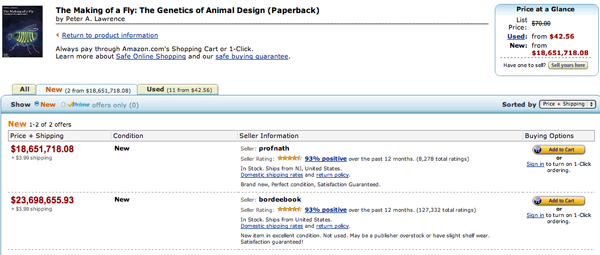The Making of a Million-Dollar Fly
Peter A. Lawrence is a developmental biologist at the University of Cambridge’s Laboratory of Molecular Biology. As his homepage’s “interests” page states, he has “a long standing interest in the formation of patterns in development,” such as the intricate imagery that forms on a butterfly’s wings. In 1992, he published his first book, titled “The Making of a Fly.” Per the book’s Amazon description page, in the treatise, Lawrence “follow[s] the developmental process from fertilization through the primitive structural development of the body plan of the fly after cleavage into the differentiation of the variety of tissues, organs and body parts that together define the fly. The developmental processes are fully explained throughout the text in the modern language of molecular biology and genetics.”
In other words, there is almost no reason, whatsoever, for most of us to read it. Put bluntly, we wouldn’t understand it. Which makes the fact that it was once for sale for over $23 million, as seen below, difficult to explain.

The price, of course, has nothing to do with the book. And no, there’s no reason to think anyone actually purchased a copy for $23 million, and not because there was another version available at $18 million and change. (During this whole process, there were likely multiple copies — probably used ones — available for $30.00 or so.) What happened? Blame a couple of competing algorithms.
As noted by Michael Eisen, a biologist at the University of California at Berkeley (who grabbed the screenshot above), a few days before the books hit these absurd prices, they were at similarly absurd yet much cheaper price points, at about $2.2 million at $1.7 million, respectively. Eisen spent those few days tracking the prices, and a pattern started emerging. Every few hours, the higher-priced seller, “bordeebook” on Amazon, would boost its price to about 1.27 times that of the second-highest, in this case, “profnath.” And a few hours later, profnath would respond, boosting its price to about .998 times that of the highest. The strategy employed by profnath seemed straight-forward — slightly undercut the highest seller in order to increase the likelihood of a sale, while still ensuring that it received an amount negligibly close to the peak price. But what’s going on with bordeebook?
Eisen floated a theory. Why profnath probably owned the book, bordeebook most likely did not. Instead, Eisen suggested, bordeebook “noticed that someone else listed a copy for sale, and so they put it up as well – relying on their better feedback record to attract buyers. But, of course, if someone actually orders the book, they have to get it – so they have to set their price significantly higher – say 1.27059 times higher – than the price they’d have to pay to get the book elsewhere.”
As of this writing, there are eight new copies of the book available on Amazon, with the cheapest selling for a much more reasonable $86.80 (plus $3.99 shipping and handling). However, the problem could occur again. One of the sellers — and not one of the two mentioned above — has a copy listed for $7,000.
Bonus fact: Three years ago — and more than two years before the “Making of a Fly” debacle came to light — a guy named Brian Klug found a CD-ROM for sale for $2.9 billion (!) on Amazon, and, as seen here, attempted to purchase it. Amazon canceled the order a few days later and, as he recalled on reddit (here), called him to discuss the order. The Amazon representative, per Klug’s reddit post, “made it clear they treat the shopper’s experience with the highest regard and they wanted to make sure it wouldn’t happen again.”
Double bonus!: In the early days of Amazon, consumers could get rich another way, with nothing more than a credit card and a dash symbol. As Amazon CEO Jeff Bezos explained in a video (here) discussing his company’s acquisition of Zappos, “customers could order a negative quantity of books, and, we would credit their credit card with the price and [. . . ] wait around for them to ship us the books.” (That bug is fixed.)
From the Archives: A Fly on the Urinal: These exist. Why?
Related: A book which teaches the reader how to make money selling stuff on Amazon. It’s about retail flipping, but probably does not suggest that you try and sell one book for a cool $23 million (or $2.9 billion for that matter).
Image via Michael Eisen’s blog post, linked above.
